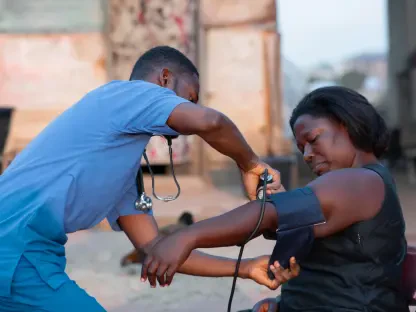Grindr, a prominent dating app primarily serving gay and bisexual men, is embarking on a journey toward transformative change. The company recently announced its first-quarter earnings, which, despite falling short of immediate expectations, prompted an increase in its full-year revenue forecast. This move reflects strategic confidence from Grindr’s leadership, under the guidance of CEO George Arison, rooted in the long-term implementation of innovative strategies. In an era where digital platforms are diversifying their services, Grindr is taking notable strides into new territories, challenging conventional notions of what a dating app can offer. As the app transitions into an unexpected sphere—telehealth—it invites a broader discussion on the future trajectory of technology in fostering not only social but also health advancements.
Financial Performance and Long-term Strategy
The latest financial results from Grindr illustrated notable growth, marked by a 25% revenue increase and an EBITDA margin over 43%, despite not meeting anticipated revenue benchmarks. This upward trend cast a light of optimism on Grindr’s future financial endeavors, with adjustments made to its annual revenue projections and EBITDA margins. CEO George Arison emphasized the company’s strategic orientation, focusing more on sustainable growth over time rather than quarterly fluctuations. Critical to this strategy has been the successful testing and early monetization of new products across various U.S. cities, allowing Grindr to capture value more promptly than originally planned. These actions have not only proven beneficial for revenue generation but have also set the stage for long-term financial stability, reinforcing Grindr’s holistic approach to its market presence and growth trajectory.
Grindr’s enhanced financial outlook reflects its broader vision to adapt and grow within the fast-evolving digital landscape. By moving beyond traditional metrics and embracing a long-term perspective, the company fosters a culture of innovation and readiness to pivot as needed. The decision to recalibrate revenue guidance by two percentage points underscores confidence in the strategies currently being rolled out. These strategies are not merely reactive but part of a larger framework engaging diverse user demands and aligning with shifting market dynamics. This anticipation and adaptability position Grindr to sustain and enhance its financial leverage, ensuring that any departures from expected performance do not undermine its committed focus on scaling and efficiency.
Resilient User Demographics
Despite global economic challenges, Grindr’s user base remains impressively resilient, with little to no adverse effects observed. The app’s users, primarily gay and bisexual men, engage with it for the fun and joyful experiences it provides rather than for reasons tied to economic or political engagement. This distinctive user orientation acts as a buffer against broader economic perturbations, enabling Grindr to maintain a stable user ecosystem even when external conditions are fluctuating. The platform has effectively carved out a niche catering to those with higher spending power, savings, and education levels, thereby ensuring that its user community is not only intact but thriving amid economic adversity.
Grindr’s value proposition, as a service offering emotional and social enrichment, appeals specifically to users seeking life’s enjoyable aspects beyond fiscal constraints. It highlights an interesting facet of digital applications—their potential to create environments independent of socioeconomic climates. The unique demographic makeup also encourages Grindr to tailor its marketing and strategic initiatives, reinforcing user loyalty and engagement. This resilience is a testament to Grindr’s profound understanding of its community’s needs and desires, steering its offerings to consistently enrich user experiences. By fostering an engaging and supportive environment, Grindr continues to fortify its standing as a preferred platform irrespective of the economy’s ebb and flow.
Evolution of User Demographics
Grindr has witnessed a significant evolution in its user demographics over recent years, reflecting societal shifts in attitudes towards sexual identity, particularly bisexuality. Originally a platform predominantly used by gay men, there is now a discernible increase in bisexual user participation, mirroring broader cultural acceptance. This demographic change signifies Grindr’s crucial role in representing and serving the multifaceted identities within the LGBTQ+ community. What began as a niche offering for a specific segment has grown to embrace a more diverse user base, thereby enriching community interactions and connections. This evolution is not just a reflection of changing societal norms but also an acknowledgment of Grindr’s adaptive strategies in meeting these newly articulated user identities.
Attractive to younger audiences, particularly those who have just reached adulthood, Grindr serves as a vibrant community, providing not just social connections but also a source of mentorship and insight from older users. This dynamic reinforces the app’s role as a digital gayborhood, where learning and guidance are as prevalent as romantic pursuits. However, Grindr also recognizes the importance of evolving alongside its user base, aspiring to maintain engagement and relevance as users age. The platform faces the challenge of enhancing its offerings to cater to different life stages, particularly for those in their late thirties. Through strategic enhancements focused on fostering more enduring relationships, Grindr continues to align itself with contemporary user expectations and societal shifts, demonstrating its enduring appeal across generations.
Changing Dating Preferences
Within Grindr’s user community, an emerging trend towards more traditional, monogamous relationships is taking root, marking a significant shift from past preferences. This change reflects broader cultural trends where individuals increasingly seek deeper, more committed partnerships. Identifying this shift as an opportunity, Grindr is focusing on adapting its platform to enhance features that facilitate long-term relationship development. This proactive response underscores Grindr’s commitment to fostering lasting connections and demonstrates its awareness of users’ evolving aspirations and relationship needs. By refining its offerings to better suit contemporary user preferences, Grindr is positioning itself as a more versatile and comprehensive platform prepared to meet diverse relationship goals.
Grindr’s plans to fully integrate features for long-term partnerships by 2026 signal a thoughtful and strategic approach to modernizing its service offerings. These enhancements are likely to include new tools and functionalities designed to support users in finding and maintaining monogamous relationships, further broadening Grindr’s appeal. In doing so, the platform aims to deepen user engagement and expand its service beyond short-term interactions. This evolution highlights not only the company’s adaptability but also its ability to capture and respond to shifts in user expectations. By acknowledging and acting upon these changes, Grindr is effectively positioning itself for continued relevance in a rapidly transforming social landscape, prepared to meet the demands of future users.
Strategic Expansion into Telehealth
Grindr’s recent venture into the telehealth sector with the introduction of Woodwork signifies a bold diversification strategy, marking the company’s first substantial move beyond its usual purview of dating and social connections. Positioned as a “gayborhood in your pocket,” Woodwork is aimed at integrating essential health services, starting with erectile dysfunction (ED) medications, directly into the user’s digital lifestyle. This strategic expansion underscores Grindr’s commitment to broadening its service offerings beyond traditional dating models, addressing a critical element of the LGBTQ+ community’s health and well-being. By offering necessary healthcare services tailored specifically for its audience, Grindr is challenging prevailing paradigms of what dating apps can achieve.
As a startup within Grindr, Woodwork facilitates innovation and agility, enabling the team to refine and adapt its services efficiently to meet specific needs of its target demographic. By partnering with Open Loop, a known entity in healthcare solutions, Woodwork promises quality services that are both unique and relatable to the gay community. This step represents Grindr’s sensitivity towards providing culturally competent healthcare access, ensuring that its branding and messaging resonate profoundly with its users. Such ventures not only illustrate Grindr’s capacity to innovate but also highlight its role in advancing accessible healthcare solutions for marginalized communities, setting a precedent for future digital health initiatives within and beyond the LGBTQ+ sphere.
Innovative Telehealth Service: Woodwork
Woodwork stands as a testament to Grindr’s innovative approach, offering a telehealth service exclusively tailored for the gay community. This service not only challenges traditional telehealth paradigms but does so in a manner that ensures the products are culturally sensitive and resonate with its users’ unique needs. Emphasizing products developed for and by gay individuals, Woodwork strives to provide an intimate understanding of its audience, contributing significantly to user trust and engagement. This distinctive branding reflects a conscious effort to align with the community’s expectations and deliver genuine value beyond standard health solutions. By operating as a niche service, Woodwork is poised to fill a critical gap in healthcare service delivery, addressing issues often overlooked by broader healthcare systems.
Grindr’s venture into telehealth not only expands its business model but reinforces its commitment to serving its community’s comprehensive needs. Through strategic collaborations and an emphasis on personalized care, Woodwork differentiates itself by offering more than just medication access—it establishes a community-centric approach to healthcare within digital spaces. As mobile technology continues to intersect with personal health management, Grindr’s initiative highlights the potential for dating apps to transform into multipurpose platforms, forging new pathways for engagement. The launch of Woodwork is a strategic step in reimagining how technology can address diverse needs, setting Grindr on a promising path of innovation and societal contribution.
Adapting to Market Demands
Grindr’s latest financial report showcased significant growth, with a 25% revenue surge and an EBITDA margin surpassing 43%, despite not reaching expected revenue targets. This promising trend ignites optimism for Grindr’s financial future, with adjustments made to annual revenue forecasts and EBITDA margins. CEO George Arison highlighted the company’s strategic focus on sustainable growth over time, rather than quarterly fluctuation. A pivotal aspect of this strategy is the effective testing and early monetization of new products across various U.S. cities, enabling Grindr to capitalize on opportunities faster than anticipated. These efforts not only boost revenue but also lay the foundation for long-term financial stability, supporting Grindr’s comprehensive market approach. Reflective of its broader vision, Grindr adapts to the rapidly changing digital landscape by emphasizing innovation and flexibility. By adjusting revenue guidance by two percentage points, Grindr exhibits confidence in its strategies, aligning with dynamic user needs and market shifts.









